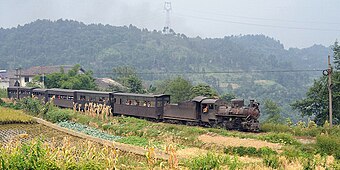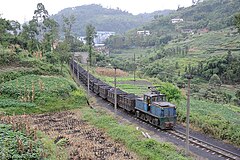Shixi – Huangcunjing railway line
| Shixi-Huangcunjing | ||||||||||||||||||||||||||||||||||||||||||||||||||||||||||||||||||||||||||||||||||||||||
|---|---|---|---|---|---|---|---|---|---|---|---|---|---|---|---|---|---|---|---|---|---|---|---|---|---|---|---|---|---|---|---|---|---|---|---|---|---|---|---|---|---|---|---|---|---|---|---|---|---|---|---|---|---|---|---|---|---|---|---|---|---|---|---|---|---|---|---|---|---|---|---|---|---|---|---|---|---|---|---|---|---|---|---|---|---|---|---|---|
| Route length: | 19.84 km | |||||||||||||||||||||||||||||||||||||||||||||||||||||||||||||||||||||||||||||||||||||||
| Gauge : | 762 mm ( narrow gauge ) | |||||||||||||||||||||||||||||||||||||||||||||||||||||||||||||||||||||||||||||||||||||||
| Power system : | 550 V = | |||||||||||||||||||||||||||||||||||||||||||||||||||||||||||||||||||||||||||||||||||||||
|
||||||||||||||||||||||||||||||||||||||||||||||||||||||||||||||||||||||||||||||||||||||||
The Shixi – Huangcunjing Railway (also known as the Jiayang Coal Railway or Shibanxi Narrow Gauge Railway ) is a narrow-gauge railway in the People's Republic of China in Sichuan Province in Qianwei County, Leshan City .
history
A coal mine had existed in Huangcunjing since 1938 , which is usually named after the nearby larger town of Bajiaogou (also known as "Bagou"). The coal was originally removed via a human-operated 600 mm narrow-gauge railway to Mamio , where the coal was loaded onto boats that took over the further transport on the Mabian River .
To simplify the removal of the coal, the construction of a railway line to Shixi began in August 1958 . The track width was 600 mm. This line was opened on July 12, 1959. As early as 1960, the route was re-gauged to 762 mm. The line was built and operated by the "Kuang de jia yang meikuang" (Jiayang coal mine). The route has a length of 19.84 kilometers. The station Mifengyan was as hairpins station running.
Initially, only coal trains ran, which were also used to transport people in the coal wagons. From the 1960s onward, passenger cars were added to the coal trains. This practice was ended in 1975 and regular passenger traffic with six pairs of trains a day was introduced. The number of passenger trains was later reduced to five, then four.
Other mines that were served by the railroad emerged at Jiaoba (now abandoned) and Yuejin . After the commissioning of a power station near Shixi, the Yuejin – Shixi section was electrified with direct current (550 volts) in 2000. It was decided to shut down the rest of the route in 2003 because the output from the Huangcunjing mine was declining. Initially, however, passenger transport remained indispensable due to the lack of road links. In May 2004, the provincial government in Sichuan applied for the railway to be classified as industrial heritage, as it saw tourism development potential for the region. In May 2010 the railway and the mine in Huangcunjing were placed under national monument protection.
Despite ongoing operations, the mine in Huangcunjing is being converted into a museum and the railway is gradually being adapted for tourist purposes. Since around 2005, special coaches for tourists have been added to passenger trains and a stopping point has been set up for special trains between Xianrenjiao and Jiaoba , where it is possible to take photos of the train. The construction of a reception building with a nostalgic design is planned in Bajiaogou station. Despite these efforts to convert it into a tourist train, which was still in its infancy, the train was still mainly used for local passenger and coal transport in 2011 due to the lack of a road.
Vehicle use
At first, converted road vehicles were used on the 600 mm gauge, later tank locomotives of an unknown design. After the gauging, tank locomotives of a larger type, possibly the type RJ , initially operated . They were later replaced by type ZM16-4 ( C2 ) locomotives with a tender . These still handle all traffic on the non-electrified section today (2011). The company numbers 07 to 15, i.e. nine locomotives, are proven for these. Of these, the 07, 09, 10 and 14 were still operational in 2011, and around 2006 they received larger tenders from locomotives on the disused Pengzhou – Baishuihe railway line . In 2011, an identical locomotive, which was also taken over from there, received a nostalgic beige paint for tourist trains and the road number 08.
In 1991 two diesel locomotives of the SJ380A series were procured, they were given the road numbers 01 and 02. As early as 1996, they were taken out of service.
In 2000, three two-axle electric locomotives of the ZL 14-7 series were procured for electrical operation between Shixi and Yuejin . These are only used with coal trains.
The coal was initially transported in wagons with a bamboo basket structure, these were later replaced by wagons with a wooden structure, today two-axle steel wagons are in use.
Two-axle wagons with open windows are used for passenger transport, four-axle wagons are used as load wagons. The tourist cars are also four-axle. They are characterized by window openings that are closed with transparent plastic and some have a brown finish.
business
Four pairs of passenger trains run the entire route every day; they need 75 minutes for each direction. Furthermore, one or two pairs of trains are usually used to transport coal between Huangcunjing and Shixi. Special trains for the transport of tourists only run if requested and when requested. Only tourist cars are used in these, of which only one or two run on the scheduled passenger trains. All of these trains are hauled by type ZM16-4 steam locomotives, including on the electrified section. The locomotives are supplied at Yuejin station on the way to Huangcunjing.
The coal transport between Yuejing and Shixi is carried out electrically, a ZL 14-7 commutes between the two loading stations about every hour.
photos
literature
- Zhang Xiang: Jiayang Narrow Gauge Steam. 2011, ISBN 978-7-80220-633-5 .
- Gao Luchuan: Jiayang Narrow Gauge Steam - A living fossil of the industrial revolution 1959 ~ 2009. China Photographic Publishing House, 2009, ISBN 978-7-80236-323-6 .
Web links
- Brief description with links to numerous travel reports (English)
- Description of railway operations and its history on the operator's side (Chinese)
- Travel report (6th part with links to the previous parts)
Individual evidence
- ↑ a b c BaShi Railway. ( Memento of the original from June 30, 2007 in the Internet Archive ) Info: The archive link was automatically inserted and not yet checked. Please check the original and archive link according to the instructions and then remove this notice. on: railwaysofchina.com
- ^ A b R. N. Pritchard: Industrial Locomotives of the People's Republic of China. Industrial Railway Society, Melton Mowbray 2008, ISBN 978-1-901556-48-3 .
- ↑ Ameling Algra: Steam in China, October 2011.




